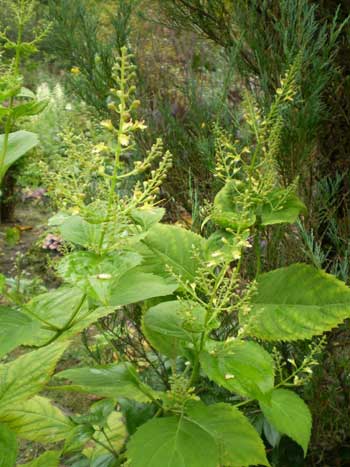Contents:
Common Names | Parts Usually Used | Plant(s) & Culture | Where Found | Medicinal Properties | Biochemical Information
Legends, Myths and Stories | Uses | Formulas or Dosages | Warning | Bibliography
Scientific Names

- Collinsonia canadensis L.
- Labiatae
- Mint family
Common Names
- Collinsonia
- Hardhack
- Hardrock
- Heal-all
- Horse-balm
- Horseweed
- Knob grass
- Knob root
- Ox-balm
- Richweed
Parts Usually Used
Rootstock, leaves
Back to Top
Description of Plant(s) and Culture
Stone root is a native North American perennial plant; the hard, knobby rootstock sends up a quadrangular stem from 1-4 feet tall, with opposite, ovate, serrate leaves which are pointed at the apex and narrowed or heart-shaped at the base. The two-lipped (with fringed lower lip), greenish-yellow, lemon-scented flowers, stamen strongly protruding, grow in a loose panicled raceme at the top of the stem from July to October.
Back to Top
Where Found
Found in rich, damp woods from Quebec to Florida and westward to Wisconsin, Missouri, and Arkansas.
Back to Top
Medicinal Properties
Diuretic, tonic, vulnerary, astringent, diaphoretic, emmenagogue, alterative
Back to Top
Biochemical Information
13,000 parts per million of rosmarinic acid, resin, starch, tannin, mucilage and a wax-like stubstance
Back to Top
Legends, Myths and Stories
In the mountains of Tennessee, Virginia, Kentucky, and Carolina, the root of this herb is considered as a panacea and is being used outwardly and inwardly for many diseases.
Back to Top
Uses
An infusion of stone root makes a good diuretic for urinary problems, female disorders, and excessive water retention. It is often included with other plants as part of a mixture. The fresh leaves can be used externally, as poultice or fomentation, to help heal wounds, sores, cuts, ulcers, sprains, burns, and bruises, poison oak and ivy. Root tea used for piles, hoarseness, laryngitis, indigestion, diarrhea, dysentery, dropsy, kidney and bladder ailments, cystitis.
A remedy in functional, vascular diseases of the heart, headache, chronic bronchitis, colic, dropsy, cramps. Seems to be safe for pregnant women.
Back to Top
Formulas or Dosages
The fresh rootstock is better than the dried.
Infusion: steep 1 tsp. rootstock in 1 cup water. Take 1 cup a day, a mouthful at a time.
Tincture: a dose is from 5-20 drops.
Back to Top
Warning
Minute doses of fresh leaves may cause vomiting.
Back to Top
Bibliography
![]() The Herb Book
The Herb Book, by John Lust, Bantam Books, 666 Fifth Avenue, New York, NY. copyright 1974.
![]() The Herbalist Almanac
The Herbalist Almanac, by Clarence Meyer, Meyerbooks, publisher, PO Box 427, Glenwood, Illinois 60425, copyright 1988, fifth printing, 1994
![]() Eastern/Central Medicinal Plants
Eastern/Central Medicinal Plants, by Steven Foster and James A. Duke., Houghton Mifflin Company, 215 Park Avenue South, New York, NY 10000
![]() Indian Herbalogy of North America
Indian Herbalogy of North America, by Alma R. Hutchens, Shambala Publications, Inc., Horticultural Hall, 300 Massachusetts Avenue, Boston, Massachusetts 02115, 1973
![]() American Folk Medicine
American Folk Medicine, by Clarence Meyer, Meyerbooks, publisher, PO Box 427, Glenwood, Illinois 60425, 1973
 Secrets of the Chinese Herbalists
Secrets of the Chinese Herbalists, by Richard Lucas, Parker Publishing Company, Inc., West Nyack, NY, 1987.
![]() Planetary Herbology
Planetary Herbology, by Michael Tierra, C.A., N.D., O.M.D., Lotus Press, PO Box 325, Twin Lakes. WI 53181., Copyright 1988, published 1992
![]() The Yoga of Herbs: An Ayurvedic Guide to Herbal Medicine
The Yoga of Herbs: An Ayurvedic Guide to Herbal Medicine, by Dr. David Frawley & Dr. Vasant Lad, Lotus Press, Twin Lakes, Wisconsin, Second edition, 1988.
 An Instant Guide to Medicinal Plants
An Instant Guide to Medicinal Plants, by Pamela Forey and Ruth Lindsay, Crescent Books (January 27, 1992).
